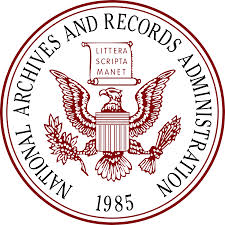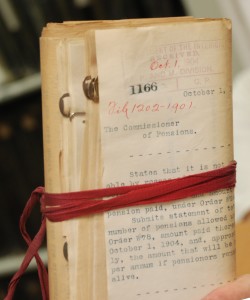 Recently a twitter follower of mine, Tammy Daniels asked me about tips for her first time visit to the National Archives and Records Administration (NARA) facility in Washington, D.C. While there is so much to learn about research at NARA, here are five tips for Tammy and anyone else considering a first visit to NARA.
Recently a twitter follower of mine, Tammy Daniels asked me about tips for her first time visit to the National Archives and Records Administration (NARA) facility in Washington, D.C. While there is so much to learn about research at NARA, here are five tips for Tammy and anyone else considering a first visit to NARA.
Tip 1: Make sure you are in the right place!
The Washington, D.C. location is just one of several NARA facilities across the United States. The facility at 700 Pennsylvania Avenue in Washington, D.C. in known for holding a variety of records key for genealogical research such as pension files from the Civil War, service records from the War of 1812, records from the General Land Office, and others. NARA’s other locations including the College Park, Maryland facility and the National Personnel Records Center in St. Louis, Missouri hold other key records for genealogists. Make sure you plan a visit to correct NARA facility that houses the collections you need.
Tip 2: Be compact and bring ID
When entering the archives you will need to enter through a metal detector before accessing the research areas. While the process can be a bit flustering it is usually much easier than making your way through airport security. When looking at textual records (aka original documents) you will need to have any paper brought in checked at the desk to ensure you haven’t stolen any of our nation’s priceless documents. To save a bit of time, reduce the amount of paper you need to bring into the facility with you. Save files to a laptop, tablet, or mobile device instead.
When you arrive you will need to show an ID and gain a visitor or research badge. The process is fairly simple. If you plan on looking at original records (which of course you do, because you are a genealogist at NARA) you will need to register for a Researcher Card. Depending upon the time of day and the number of visitors, the process should take anywhere from 15 to 45 minutes. NARA’s helpful staff will take your picture and give you a researcher card that gives you an official researcher number. Keep track of your card and number, as you will need them to request documents and make any copies.
Tip 3: Prepare ahead of time
NARA’s staff will help you navigate through the maze of record groups to help you request the original files you need – but it helps if you bring a copy of any indexes you might have. For example, when seeking an original Civil War Pension file, bring a copy of the index card to assist you in filing out the request slip. You are usually limited to the number of requests you can submit at a given time, so make sure you prioritize your requests before arriving.
groups to help you request the original files you need – but it helps if you bring a copy of any indexes you might have. For example, when seeking an original Civil War Pension file, bring a copy of the index card to assist you in filing out the request slip. You are usually limited to the number of requests you can submit at a given time, so make sure you prioritize your requests before arriving.
This is important for any first time visitor: NARA only pulls original documents at certain times during the day. Plan to arrive at least an hour ahead of the first pull time to work your way through the request process. There is nothing worse than arriving with only 10 minutes before the final pull of the day (a hint, you probably won’t have time to view the records you want!).
A large number of NARA documents (or at least their indexes) have been digitized on sites like Fold3.com, Ancestry.com, and FamilySearch.org. Check each of those sites before visiting to save time when visiting NARA in person
Tip 4: Lockers and a quarter
Once inside there are lockers provided to secure your bags and other belongings. They are free to use but do require a quarter to lock correctly. Make sure you bring a quarter with you when visiting to ensure you can lock your valuables. Bags and other bulky items are not allowed in the actual room you use to view original records. When visiting, I try to limit myself to just a laptop when viewing any textual documents. Take some time learn more about the research rooms before visiting.
Tip 5: Make copies and take photos
Once inside the research room with documents in hand (it usually takes about 45 minutes for a record to be pulled), you need to ask permission before copying any materials. NARA does allow you to make paper and digital copies. Pension files, service records, land entry files, etc. usually get the “all clear” from the desk to copy – but always check first.
You can load your research card with money from a credit/debit card or by cash using a machine located in the room where you view original documents or online (thanks to my colleague EasternEuropeanMutt for the link). You can also take photos with your mobile device or a portable camera. Be sure to copy the front and back of documents, and keep your images in order.
Last Words
So there you have it – five quick tips for a first time visit to Archives I in Washington, D.C. There is so much more to learn (and I learn something new about our nation’s archives every trip I take). Tammy, I hope you have a wonderful experience at NARA and that you find exactly what you are looking for. For all you other fellow genealogists, may your future visits to NARA be productive and full of adventure. Now, what are your tips for a first time visitor?
Make sure to visit our Instagram account, we just bought cheap Instagram views and are very to show you our content.



